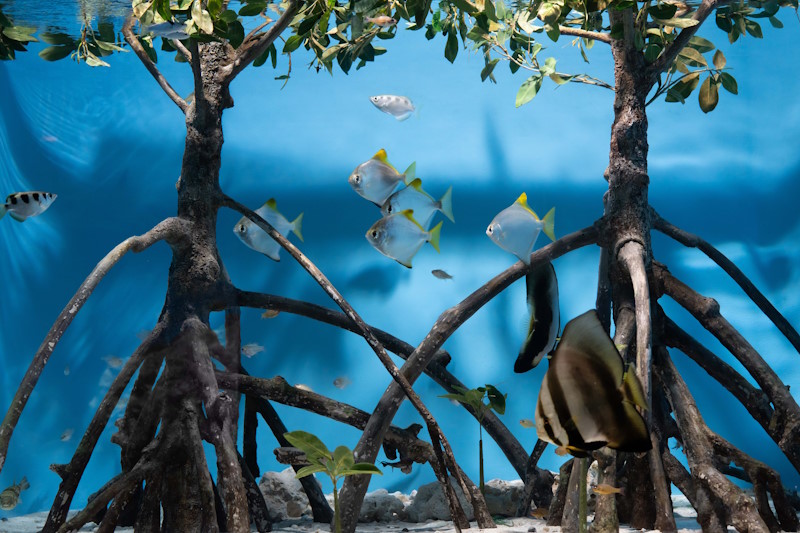
Maintaining a healthy and vibrant aquarium requires more than just feeding your fish and adjusting the lights. One of the most critical aspects is performing regular water changes.
But when you have mangroves in your tank, you might wonder how these water changes impact these unique plants.
So let’s take a look at how the relationship between water changes and mangroves is crucial for both your tank and your mangroves to thrive.
The Role of Water Changes in Aquarium Health
Water changes are vital for the well-being of all aquarium inhabitants. They help remove waste, excess nutrients, and contaminants that build up over time. Regularly replacing a portion of the water not only maintains water quality but also prevents the accumulation of harmful substances that could stress or harm your fish and plants, including mangroves.
Benefits of Regular Water Changes
When you perform regular water changes, you’re effectively resetting your tank’s water chemistry. This process introduces fresh water into the tank, diluting any built-up toxins and balancing the nutrient levels. For aquarists with high bioload tanks—where the number of fish and plants is high relative to the tank’s size—this is particularly important.
Good Water Maintenance: ✅ Regular, consistent water changes that match the needs of your tank
Bad Water Maintenance: ❌ Infrequent or irregular water changes that lead to unstable water conditions
How Often Should You Change the Water?
The frequency of water changes depends on several factors, including the size of your tank, the number of inhabitants, and whether you have a saltwater, freshwater, or brackish setup. Generally, a 10-20% water change every one to two weeks is recommended. This frequency helps maintain stable water parameters, ensuring a healthy environment for all your aquatic life.
Good Water Change Frequency: ✅ Weekly or bi-weekly changes
Bad Water Change Frequency: ❌ Monthly or less frequent changes
Understanding Mangroves in Your Aquarium
Mangroves are unique plants that bring both aesthetic and ecological benefits to your aquarium. Their ability to absorb nutrients directly from the water makes them excellent natural filters, but it also makes them sensitive to changes in water chemistry. When you have mangroves in your tank, understanding their specific needs during water changes is crucial.
Mangroves and Nutrient Absorption
Mangroves are natural sponges when it comes to nutrients. They absorb nitrates, phosphates, and other compounds directly from the water, helping to improve overall water quality. This characteristic is beneficial for reducing algae growth, as mangroves compete with algae for these nutrients.
Good Nutrient Balance: ✅ Stable levels of nitrates and phosphates, balanced with water changes
Bad Nutrient Balance: ❌ Sudden drops or spikes in nutrient levels after water changes
Maintaining a consistent nutrient level is essential for mangroves. Sudden changes, such as those caused by large water changes, can disrupt this balance and stress the plants. It’s crucial to monitor these levels and adjust your water change routine to accommodate the needs of your mangroves.
🛑 Fun Fact: Did you know that mangroves can help reduce algae growth in your tank by absorbing excess nutrients? Their roots act like a natural sponge, soaking up the nutrients that algae need to thrive!
Best Practices for Water Changes with Mangroves
When performing water changes in a tank with mangroves, a gradual approach is best. Large, sudden changes in water chemistry can shock the plants, leading to yellowing leaves, slowed growth, or even plant death. Here’s how to ensure your water changes support, rather than hinder, your mangroves’ growth.
Gradual Water Changes
Instead of doing a large water change all at once, spread it out over a couple of days. This method allows the mangroves to adjust gradually to the new water conditions, reducing the risk of shock. For instance, if you typically change 20% of the water at once, consider changing 10% one day and another 10% the next day.
Good Water Change Method: ✅ Gradual water changes spread over several days
Bad Water Change Method: ❌ Large, sudden water changes that cause rapid fluctuations
Salinity Stability for Mangroves
For those keeping mangroves in saltwater or brackish tanks, maintaining consistent salinity levels is crucial. Mangroves are adapted to varying salinity levels in their natural habitats, but they prefer stability in an aquarium setting.
When performing water changes, ensure the new water matches the tank’s existing salinity levels. Sudden shifts in salinity can cause stress to the mangroves, leading to leaf drop and other signs of distress.
Good Salinity Management: ✅ Matching the salinity of new water with tank water
Bad Salinity Management: ❌ Adding water with different salinity levels, causing stress
The Impact of Water Quality on Mangroves
Water quality is another critical factor in the health of your mangroves. In addition to regular water changes, monitoring the pH, hardness, and other water parameters is essential to creating an environment where mangroves can thrive.
pH and Hardness Considerations
Mangroves generally prefer slightly alkaline water, with a aquarium pH range between 7.5 and 8.5. If your tank’s pH fluctuates frequently, it can affect the mangroves’ ability to absorb nutrients. Similarly, water hardness should be kept stable, as large swings can cause stress to the plants.
Good pH and Hardness Levels: ✅ Stable pH and hardness levels within the preferred range
Bad pH and Hardness Levels: ❌ Frequent fluctuations that lead to nutrient absorption issues
🛑 Fun Fact: Mangroves are incredibly resilient and can survive in a range of water conditions, but they thrive best in stable environments where pH and salinity remain consistent!
Personal Experience with Mangroves and Water Changes
In my years of keeping mangroves, I’ve learned that while they’re tough plants, they still require attentive care, especially when it comes to water changes. I recall an early experience where I mistakenly did a large water change all at once, not realizing the impact it would have on my mangroves.
The sudden change in water chemistry caused the leaves to yellow, and it took weeks for the red mangrove plants to recover. Since then, I’ve adopted a more gradual approach to water changes, and my mangroves have thrived ever since.
This personal experience taught me the importance of understanding your tank’s ecosystem. While it’s tempting to do a quick water change to refresh the tank, taking the time to do it gradually can make all the difference for sensitive plants like mangroves.
Water Changes for Different Types of Tanks
Whether your tank is saltwater, freshwater, or brackish, water changes play a crucial role in maintaining the health of your mangroves.
Saltwater Tanks
In saltwater tanks, maintaining precise water chemistry is essential. Water changes help stabilize pH, alkalinity, and salinity levels, which are critical for the health of both your fish and your mangroves. In these environments, even minor fluctuations can have significant impacts, so it’s important to monitor these parameters closely during water changes.
Good Saltwater Maintenance: ✅ Regular monitoring and adjustments to maintain stable water chemistry
Bad Saltwater Maintenance: ❌ Ignoring pH, alkalinity, and salinity levels, leading to stress in mangroves
Freshwater and Brackish Tanks
For freshwater and brackish tanks, the principles are similar, but the specific water parameters will differ. Brackish water, which is a mix of freshwater and saltwater, presents unique challenges in maintaining stable salinity levels. Regular water changes help remove excess nutrients, but it’s important to match the water’s salinity and hardness to the tank’s existing conditions.
Good Freshwater/Brackish Maintenance: ✅ Tailoring water changes to the specific needs of the tank
Bad Freshwater/Brackish Maintenance: ❌ One-size-fits-all approach to water changes, neglecting the tank’s unique conditions
Water changes are a fundamental part of aquarium maintenance, and when done correctly, they can support the health and growth of your mangroves. By understanding the specific needs of these unique plants, you can adjust your water change routine to keep your tank thriving.
Remember, proper care—including regular water changes—will help your mangroves flourish and contribute to a vibrant, balanced aquarium ecosystem.
How Do I Choose My Very First Plant?
So you have learned about the incredible benefits of adding mangrove plants to your tank, but you still don’t know which exact plant to add to your specific tank size?
Don’t worry, because we’ve created an easy Step-by-Step guide to help you with your selection process.
Click the button below to find out which plant is perfect for your aquarium.

 Cart is empty
Cart is empty 
